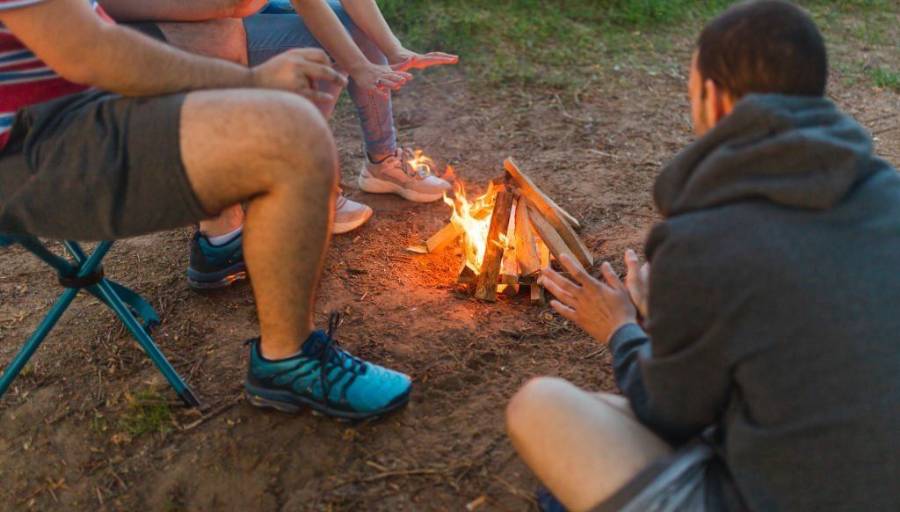How to Start a Fire without a Lighter

Starting a fire is a fundamental survival skill that has been practiced by humans for thousands of years. While modern tools such as lighters and matches make fire-starting convenient, there are situations where you find yourself without these conveniences.
In this guide, we will explore several methods to start a fire without a lighter. From primitive techniques like friction-based methods to more modern approaches using everyday items, you’ll discover a range of options to suit different scenarios.
8 Fire-Starting Techniques: No Lighter Needed!
1. Friction-Based Methods
- Hand Drill: This technique involves rotating a wooden stick between your palms to create friction against a fireboard. The resulting heat will eventually generate an ember that can be transferred to a tinder bundle.
- Bow Drill: The bow drill method utilizes a bow, a wooden spindle, a fireboard, and a socket. By rapidly moving the bow back and forth, you create rotational friction, generating an ember that can ignite your tinder.
2. Fire Plow
This method involves using a hardwood stick and a fireboard. By applying downward pressure and vigorously rubbing the stick back and forth along the groove in the fireboard, you create enough friction to produce an ember.
3. Flint and Steel
4. Fire Piston
A fire piston is a small tube with a piston inside. When the piston is rapidly pushed into the tube, the compression of air creates heat, igniting a small piece of tinder placed at the end of the piston.
5. Magnifying Lens
Utilizing the power of the sun, a magnifying lens, such as a magnifying glass or even a clear water bottle filled with water, can focus sunlight onto a piece of tinder, generating enough heat to start a fire.
6. Fire from Ice
By using a clear piece of ice as a lens, the same principle as the magnifying lens method can be applied. Shape the ice into a lens shape and focus sunlight onto the tinder to create a fire.
7. Chemical Reactions
Certain chemicals, such as potassium permanganate and glycerin, can create an exothermic reaction when combined, generating enough heat to ignite tinder. It’s essential to exercise caution when working with chemicals and ensure proper ventilation.
8. Electric Spark
If you have a battery and a steel wool pad or a piece of fine-grade steel wool, touching the battery terminals to the steel wool creates an electric current that generates sparks, which can ignite the steel wool. Use caution when handling batteries.
Tips:
- Prepare a tinder bundle: Collect dry, fluffy materials like bark, wood shavings, dry grass, or bird feathers to create a tinder bundle that will catch and hold the ember.
- Gather kindling: Have a variety of small, dry sticks and twigs ready to add to the growing flame once the tinder bundle ignites.
- Create airflow: Ensure there is sufficient airflow by leaving gaps between the kindling to allow oxygen to fuel the fire.
- Keep safety in mind: Always practice fire safety by choosing a suitable location away from flammable materials, having a fire extinguishing method nearby, and fully extinguishing the fire when you’re finished.
Frequently Asked Questions
Is it legal to start a fire without a lighter?
The legality of starting a fire without a lighter depends on your location and the specific circumstances. In many areas, it is permissible to start fires for cooking or warmth while camping or in designated fire pits. However, it is crucial to check local regulations and obtain any necessary permits before starting a fire.
What is the best method for starting a fire without a lighter?
The best method for starting a fire without a lighter depends on various factors such as available resources, skill level, and the specific situation. Friction-based methods like the bow drill or hand drill are reliable but require practice. Flint and steel or using a magnifying lens are also effective methods. It’s a good idea to learn and practice multiple techniques to be prepared for different scenarios.
What materials should I use for tinder?
Tinder refers to easily ignitable materials used to catch the spark or ember and start the fire. Good tinder options include dry grass, birch bark, wood shavings, cotton balls, char cloth, or a mixture of fine, dry natural fibers. Ensure your tinder is dry and easily combustible to increase your chances of success.
Can I use any rocks for the flint and steel method?
For the flint and steel method, it’s important to use rocks that contain high amounts of quartz or flint. These rocks are harder and more likely to produce sparks when struck against a high-carbon steel object. Look for rocks with sharp edges that can chip and create sparks upon impact.
Are there any safety precautions I should take when starting a fire without a lighter?
Yes, safety is paramount when starting a fire. Here are some key precautions to follow:
- Choose a safe location away from flammable materials, such as dry grass, leaves, or overhanging branches.
- Clear the area around the fire site, creating a fire break.
- Keep a bucket of water or sand, a fire extinguisher, or a fire blanket nearby for emergencies.
- Monitor the fire at all times and never leave it unattended.
- Completely extinguish the fire by pouring water over it and stirring the ashes until they are cold to the touch.
Can I start a fire without a lighter in wet or rainy conditions?
Starting a fire in wet or rainy conditions can be challenging, but it is not impossible. Look for dry or sheltered areas where you can find dry materials for your tinder and kindling. You may need to collect small, dry branches from under trees or use a knife to shave off the wet outer layer of wood. Also, consider using fire starters designed to ignite in damp conditions or techniques like the flint and steel method, which can create sparks even in wet environments.
Conclusion
Learning how to start a fire without a lighter is a valuable skill that can enhance your outdoor experiences, provide a means of survival in emergency situations, and connect you with ancient human traditions. In this guide, we have explored various techniques and each method offers a unique approach to ignite flames.
Remember, mastering fire-starting techniques takes practice. Experiment with different methods and materials, and build your skills in a controlled environment before relying on them in a real survival situation. Practice these techniques in a safe and controlled environment to develop your skills.




